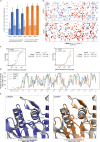Microfluidic deep mutational scanning of the human executioner caspases reveals differences in structure and regulation
- PMID: 35013287
- PMCID: PMC8748541
- DOI: 10.1038/s41420-021-00799-0
Microfluidic deep mutational scanning of the human executioner caspases reveals differences in structure and regulation
Erratum in
-
Correction to: Microfluidic deep mutational scanning of the human executioner caspases reveals differences in structure and regulation.Cell Death Discov. 2022 Feb 18;8(1):71. doi: 10.1038/s41420-022-00873-1. Cell Death Discov. 2022. PMID: 35181668 Free PMC article. No abstract available.
Abstract
The human caspase family comprises 12 cysteine proteases that are centrally involved in cell death and inflammation responses. The members of this family have conserved sequences and structures, highly similar enzymatic activities and substrate preferences, and overlapping physiological roles. In this paper, we present a deep mutational scan of the executioner caspases CASP3 and CASP7 to dissect differences in their structure, function, and regulation. Our approach leverages high-throughput microfluidic screening to analyze hundreds of thousands of caspase variants in tightly controlled in vitro reactions. The resulting data provides a large-scale and unbiased view of the impact of amino acid substitutions on the proteolytic activity of CASP3 and CASP7. We use this data to pinpoint key functional differences between CASP3 and CASP7, including a secondary internal cleavage site, CASP7 Q196 that is not present in CASP3. Our results will open avenues for inquiry in caspase function and regulation that could potentially inform the development of future caspase-specific therapeutics.
© 2021. The Author(s).
Conflict of interest statement
The authors declare no competing interests.
Figures



References
-
- Graham RK, Deng Y, Slow EJ, Haigh B, Bissada N, Lu G, et al. Cleavage at the Caspase-6 Site Is Required for Neuronal Dysfunction and Degeneration Due to Mutant Huntingtin. Cell. 2006;125:1179–91. - PubMed
Grants and funding
LinkOut - more resources
Full Text Sources
Research Materials

